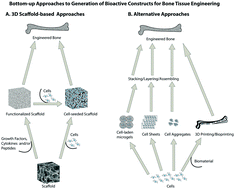Approaches for building bioactive elements into synthetic scaffolds for bone tissue engineering
Abstract
Bone tissue engineering (BTE) is emerging as a possible solution for regeneration of bone in a number of applications. For effective utilization, BTE scaffolds often need modifications to impart biological cues that drive diverse cellular functions such as adhesion, migration, survival, proliferation, differentiation, and biomineralization. This review provides an outline of various approaches for building bioactive elements into synthetic scaffolds for BTE and classifies them broadly under two distinct schemes; namely, the top-down approach and the bottom-up approach. Synthetic and natural routes for top-down approaches to production of bioactive constructs for BTE, such as generation of scaffold–extracellular matrix (ECM) hybrid constructs or decellularized and demineralized scaffolds, are provided. Similarly, traditional scaffold-based bottom-up approaches, including growth factor immobilization or peptide-tethered scaffolds, are provided. Finally, a brief overview of emerging bottom-up approaches for generating biologically active constructs for BTE is given. A discussion of the key areas for further investigation, challenges, and opportunities is also presented.


 Please wait while we load your content...
Please wait while we load your content...